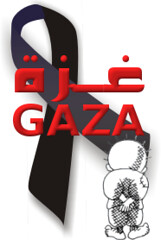
Fonte:EI foto: AP on Yahoo
Israeli settlers terrorize Palestinian villagers
Mel Frykberg, The Electronic Intifada, 11 March 2009
AL-TUWANI, occupied West Bank (IPS) - "I couldn't run. My pregnancy was too far advanced and there was nowhere to hide," said Amna Salman Rabaye, 31, as she recalled the terrifying incident several months ago.
Rabaye from the Palestinian Bedouin village of al-Tuwani in the southern West Bank was grazing her sheep when she was assaulted by a security guard from the adjacent illegal Israeli settlement of Ma'on.
"We saw a group of masked Israeli settlers armed with sticks and chains heading towards us. The younger shepherds ran and managed to escape, leaving me with the flock of sheep," Rabaye told IPS.
"It was physically impossible for me to run and I also didn't want the settlers to kill or steal my sheep. The security guard pushed me over but I was not injured," recalled Rabaye who was then seven months pregnant.
Al-Tuwani was established over 300 years ago by nomadic tribes of Bedouin who first moved into the area seeking shelter in the nearby caves. However, Israeli settlers built the adjacent Ma'on settlement in 1982. The nearby illegal outpost of Havot Ma'on was built at a later date.
Outposts normally comprise small settlements ranging from a few caravans, which are sometimes connected to water and electricity, to slightly larger settlements. They are referred to as outposts by the media as they are generally not recognized by the Israeli government.
The settlements, however, which are legal under Israeli law can number from several hundred residents to small towns with thousands of inhabitants, and all the associated infrastructure.
There are nearly 300,000 Israeli settlers living in the West Bank and nearly 200,000 in East Jerusalem, according to the Israeli information center for human rights B'Tselem.
Under international law, including various UN Security Council resolutions, the settlements are built illegally on Palestinian land.
The Fourth Geneva Convention prohibits an occupying power from transferring citizens from its own territory to the occupied territory (Article 49). The Hague Regulations prohibit an occupying power from undertaking permanent changes in the occupied area unless these are due to military needs in the narrow sense of the term, or unless they are undertaken for the benefit of the local population.
Nevertheless Israeli settlement building on the West Bank has accelerated at an unprecedented rate in the last few years.
This has included the enlargement of already existing settlements and the establishment of new ones, contrary to every understanding and peace agreement between Israel and the Palestinians.
Israeli human rights group Peace Now released a report several weeks ago stating that the Israeli government is currently building an additional 73,300 illegal housing units in the West Bank. The report added that this would increase the total number of Israeli settlers in the area by 100 percent.
International human rights organizations have argued that the motive behind the accelerated settlement building is to establish facts on the ground and to make the establishment of a viable, contiguous and independent Palestinian state near impossible.
Currently the West Bank is effectively divided into three cantons by military checkpoints and the settlements. Palestinian towns and villages are surrounded by Israeli settlements while swathes of their land has been confiscated to build settlers-only bypass roads.
While Israeli officials are furthering the facts-on-the-ground scenario through official government policies, an unofficial war between Israeli settlers and Palestinian villagers over the continued land expropriation continues unabated.
"The settlers are carrying out a deliberate policy to try and drive us off our land and intimidate us into leaving so that they can take our land," said Hafez Hreini, 37, one of the villagers. Hreini's mother, 79-year-old Fatima, was left bleeding after a settler threw a rock at her head in another encounter with the settlers.
"It is very hard not to physically retaliate when you see people attack your elderly mother but I know if I had done anything back, the Israelis would have used this as an excuse to arrest me and a lot worse," Hreini told IPS. "So we are deliberately applying a policy of non-violence and we are determined to stay here and keep our land."
In 2006 the villagers lost over 100 sheep after the settlers sprayed pesticides on their grazing land. Several donkeys belonging to the village were stabbed to death. The village's water wells have also been poisoned on numerous occasions while crops have been set ablaze. The children of the village and the surrounding villages have been regularly attacked by the settlers as they try to make their way to school.
A group of outraged Israeli intellectuals wrote to incumbent Israeli Prime Minister Ehud Olmert several years ago requesting action be taken against the settlers. This led former Israeli Defense Minister Amir Peretz to order the demolition of Havot Ma'on settlement but the demolition never took place.
The Israeli Knesset, or parliament, also ordered the Israeli army to escort children to and from school to protect them from the settlers. But according to international members of the Christian Peacemaker Teams (CPT) who live in the village, the army patrols are irregular, unreliable and sometimes sources of hostility towards the children.
The CPT have created their own school escorts for the children, and have themselves been assaulted by the settlers. One member received head injuries severe enough to require hospitalization.
The Israeli police seem disinterested. "It doesn't help if we go to the police because they never do anything," Sreini told IPS.
The Israeli rights group Yesh Din has stated repeatedly that only a very small number of settler attacks against Palestinians are investigated by the Israeli police. These result in even fewer arrests and practically no convictions.
All rights reserved, IPS - Inter Press Service (2009).







 'Clinton was the star; Mubarak celebrated his achievement in getting them all together.'
'Clinton was the star; Mubarak celebrated his achievement in getting them all together.' 












